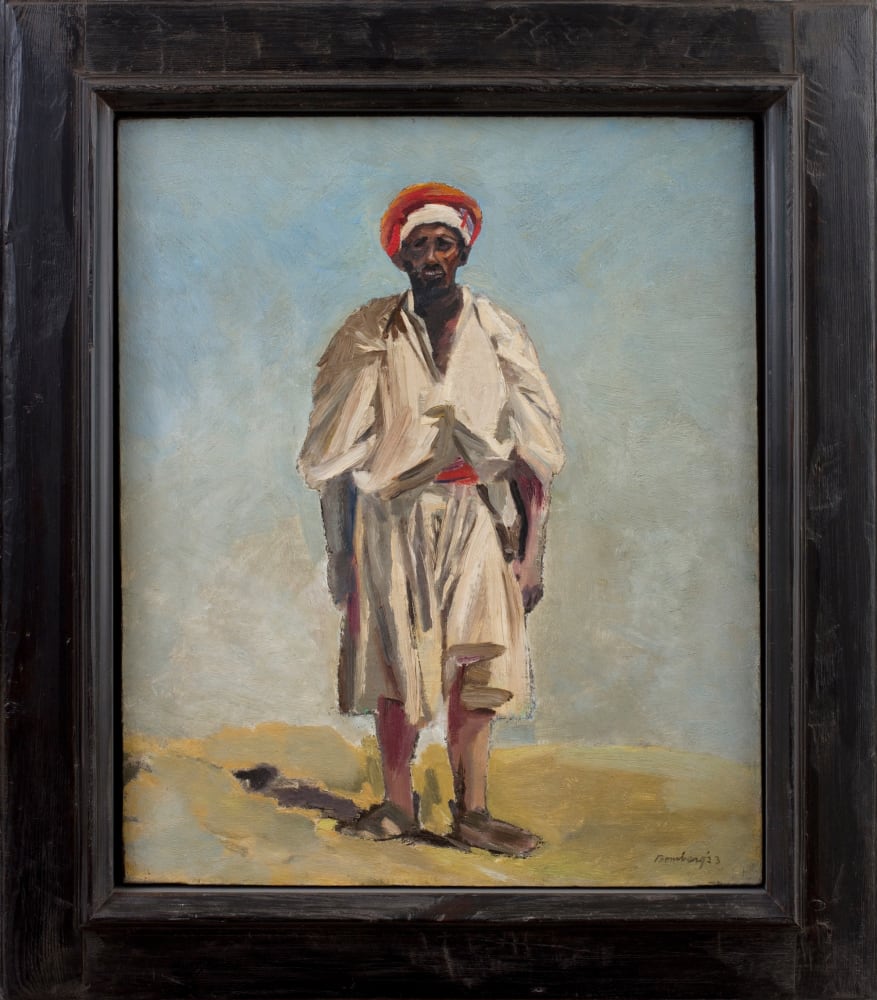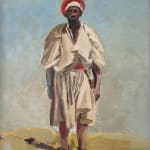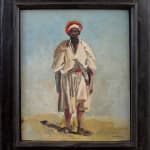David Bomberg
The Man from Hebron, 1923
Oil on canvas
61.5 x 51.5 cm
24 1/4 x 20 1/4 in
24 1/4 x 20 1/4 in
Copyright The Artist
The Man from Hebron depicts a single standing figure, dressed according to the local customs of Muslim Palestine with a keffiyeh (headdress), loose-fitting thobe and sandals. Bright notes of localised...
The Man from Hebron depicts a single standing figure, dressed according to the local customs of Muslim Palestine with a keffiyeh (headdress), loose-fitting thobe and sandals. Bright notes of localised colour are provided by the red headdress and belt. The man possibly belonged to a Bedouin tribe, Arabic nomads who lived in the desert; the sparce setting implies as much. He stands on sandy ground facing into the sun, his silhouette etched against the warm blue sky and a truncated shadow cast to the left. The low horizon magnifies his presence, relegating the desert surroundings to the lower edge of the picture. The title refers to a city in the Judean Mountains, Hebron, which lies around thirty miles south of Jerusalem and twenty-five miles west of the Dead Sea. Its population was predominantly Muslim at the time of Bomberg’s visit there in 1923 and continues to be today.
Bomberg and his wife Alice were in Palestine between April 1923 and October 1927, with Bomberg initially producing paintings and drawings of Jerusalem for the Zionist Organisation. While living there, he made friends with British government officials including Sir Ronald Storrs and Austen St B. Harrison who were beneficent patrons and admirers of the work he produced in Palestine. In a biographical note about Bomberg written in 1928, it was said:
"After the war he was sent (on the recommendation of Mr. Muirhead Bone) to Palestine, under the auspices of the Zionist Organisation. He soon gave up working specifically for the Zionists, and painted entirely for himself from nature in the open-air."
It was a productive transitional phase in Bomberg’s career during which his approach shifted considerably. Whereas before he had been a vigorous, clear-minded advocate of ‘pure form’, an avant-garde artist whose work responded to Cubism and developed the premises of Vorticism, in the early twenties he became interested in topographical accuracy and the play of light and atmosphere. The Man from Hebron demonstrates how his work became more naturalistic at this time, even as it retained an inventive approach to mark-making. The broken brushwork used to treat the man’s garments is direct, with broken brushstrokes used to conjure each fold and sag in the material.
The terms of Bomberg’s employment by the Zionist Organisation were such that an exhibition was expected at the end of his time in Palestine. This he and his wife attempted to arrange in the summer of 1926. However, owing to the radically altered appearance of Bomberg’s work, galleries were reticent to accept his proposal and the earliest arrangement possible was an exhibition at the Leicester Galleries in February 1928. The Man from Hebron was included in that exhibition, entitled Paintings of Palestine and Petra by David Bomberg, along with related works such as On the road to Hebron (no. 12) and Camels (no. 40). Many other works in the exhibition depicted scenic views of Jerusalem, Jericho and Petra. Fifty-six paintings were included in the show in total, a considerable number that demonstrates Bomberg’s depth of engagement with the region and the rush of productive creativity he experienced while there. Only seven paintings sold, however, and Bomberg found himself indebted to the gallery owing to framing and other costs.
The understanding and critical appreciation of Bomberg’s Palestinian period has developed considerably since that time. Even as Bomberg’s reputation experienced a resurgence shortly after his death, with a retrospective held at the Tate Gallery in 1967, there was still a limited grasp of the Palestine work. In the catalogue, it was written: ‘The topographical paintings remain something of a puzzle. […] It seems more likely that they were painted as a kind of discipline, a necessary discipline for an artist who was for the first time devoting all his attention to painting from nature.’ Far from a ‘necessary discipline’, the artistic quality of his work at this time has since been recognised by collectors such as the architect Colin St John Wilson, who owned two Palestinian works. Several works of this period have entered public collections since the 1980s.
Bomberg and his wife Alice were in Palestine between April 1923 and October 1927, with Bomberg initially producing paintings and drawings of Jerusalem for the Zionist Organisation. While living there, he made friends with British government officials including Sir Ronald Storrs and Austen St B. Harrison who were beneficent patrons and admirers of the work he produced in Palestine. In a biographical note about Bomberg written in 1928, it was said:
"After the war he was sent (on the recommendation of Mr. Muirhead Bone) to Palestine, under the auspices of the Zionist Organisation. He soon gave up working specifically for the Zionists, and painted entirely for himself from nature in the open-air."
It was a productive transitional phase in Bomberg’s career during which his approach shifted considerably. Whereas before he had been a vigorous, clear-minded advocate of ‘pure form’, an avant-garde artist whose work responded to Cubism and developed the premises of Vorticism, in the early twenties he became interested in topographical accuracy and the play of light and atmosphere. The Man from Hebron demonstrates how his work became more naturalistic at this time, even as it retained an inventive approach to mark-making. The broken brushwork used to treat the man’s garments is direct, with broken brushstrokes used to conjure each fold and sag in the material.
The terms of Bomberg’s employment by the Zionist Organisation were such that an exhibition was expected at the end of his time in Palestine. This he and his wife attempted to arrange in the summer of 1926. However, owing to the radically altered appearance of Bomberg’s work, galleries were reticent to accept his proposal and the earliest arrangement possible was an exhibition at the Leicester Galleries in February 1928. The Man from Hebron was included in that exhibition, entitled Paintings of Palestine and Petra by David Bomberg, along with related works such as On the road to Hebron (no. 12) and Camels (no. 40). Many other works in the exhibition depicted scenic views of Jerusalem, Jericho and Petra. Fifty-six paintings were included in the show in total, a considerable number that demonstrates Bomberg’s depth of engagement with the region and the rush of productive creativity he experienced while there. Only seven paintings sold, however, and Bomberg found himself indebted to the gallery owing to framing and other costs.
The understanding and critical appreciation of Bomberg’s Palestinian period has developed considerably since that time. Even as Bomberg’s reputation experienced a resurgence shortly after his death, with a retrospective held at the Tate Gallery in 1967, there was still a limited grasp of the Palestine work. In the catalogue, it was written: ‘The topographical paintings remain something of a puzzle. […] It seems more likely that they were painted as a kind of discipline, a necessary discipline for an artist who was for the first time devoting all his attention to painting from nature.’ Far from a ‘necessary discipline’, the artistic quality of his work at this time has since been recognised by collectors such as the architect Colin St John Wilson, who owned two Palestinian works. Several works of this period have entered public collections since the 1980s.
Provenance
Arthur A. Stambois, possibly purchased directly from the artist in 1936Stanley Mann, 1961
Eithne Maureen Mann (née Milne) (1937-2018), wife of the above, by descent
Private Collection, by descent
Exhibitions
1928, London, Leicester Galleries, Paintings of Palestine and Petra by David Bomberg, Feb. 1928, cat. no. 421929, Birmingham, The Ruskin Gallery, An Exhibition of Paintings and Drawings of Palestine and Petra by David Bomberg, Feb. 1929, cat. no. 20
1
of
5




